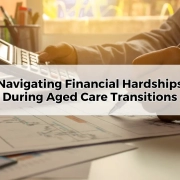What is Consumer Directed Care?
Table of Contents
ToggleAs Australia’s population ages, more and more people are finding themselves in the position of needing to care for an elderly relative. In many cases, this means providing them with consumer directed care (CDC). But what is CDC, exactly? And how can you make sure that your loved one gets the best possible care under this arrangement? Read on for answers to these questions and more.
What is consumer directed care in Australia?
Consumer directed care (CDC) is a way of providing services to people who need care and support. It gives people more control over their care, and how it is delivered.
Under CDC, people can choose their own care provider, and design their own care plan. They can also have a say in how their budget is spent.
Consumer directed care was first introduced in Australia in 1997. It has since been adopted by many other countries around the world.
There are many benefits of CDC. It gives people more control over their own lives, and leads to better outcomes for everyone involved.
If you’re considering CDC for yourself or someone you know, get in touch with a care provider today to find out more.
How does it work?
Consumer directed care is a way of giving people more control over their own care. It puts the consumer in the driver’s seat, so to speak, and allows them to make decisions about their own care. This can include things like what kind of care they receive, how often they receive it, and who provides it.
The concept of CDC is gaining popularity in Australia. There are a number of reasons for this, including the fact that it gives consumers more control over their own care, and that it can lead to better health outcomes.
There are a few different models of CDC, but all of them share some common features. These include:
- Empowering consumers to make decisions about their own care
- Giving consumers more control over the services they receive
- Providing consumers with information and support to make informed choices
CDC is currently being piloted in a number of different settings across Australia. These include aged care, disability services, and mental health services. The goal of these pilots is to test whether consumer directed care can lead to better outcomes for consumers.
So far, the evidence from these pilots is promising. CDC appears to be leading to better health outcomes, and higher levels of satisfaction among consumers. There are also some indications that consumer directed care may help to reduce costs.
The Australian government is currently working on a national rollout of consumer directed care. This will involve introducing CDC into more settings, and making it available to more people. The goal is to have CDC available to all Australians by 2020.

Who benefits from it?
Consumer directed care is a type of funding arrangement that gives consumers more control over their own care. In Australia, CDC is seen as a way to improve the quality of care and increase consumer choice.
There are many benefits to CDC, including improved health outcomes, increased consumer satisfaction, and greater control over one’s own care. Additionally, CDC can help to reduce costs by giving consumers the ability to choose less expensive providers.
Overall, consumer directed care is beneficial for both consumers and providers. It provides consumers with more choice and control over their own care, while also helping to improve the quality of care. Additionally, it can help to reduce costs by giving consumers the ability to choose less expensive providers.
What are the basic principles of consumer directed care?
Consumer directed care is a model of care delivery in which consumers have greater control over their own care. This can include things like choosing their own provider, setting their own goals, and being more involved in decision-making about their care.
There are several key principles that underpin consumer directed care:
Consumers have the right to choose their own providers
This means that consumers can choose who they want to provide their care, and they are not restricted to only using services from a particular provider or organisation.
Consumers are involved in decision-making about their care
This means that consumers have a say in how their care is delivered, and they are not just passively receiving services from providers. They should be involved in decisions about things like what services they need, how those services are delivered, and what their goals are.
Consumers have control over their own care
This means that consumers can make decisions about their own care, and they are not just reliant on providers to make all the decisions for them. They should be able to choose things like when and where they receive care, and what type of care they receive.
These principles give consumers more control over their own care, and allow them to be more involved in decision-making about their care. This can lead to better outcomes for consumers, as they are more likely to be satisfied with care that is tailored to their individual needs and preferences.
Are there any drawbacks to this system?
There are a few potential drawbacks to consumer directed care in Australia. One is that it could lead to more out-of-pocket expenses for consumers. This is because consumer directed care generally means that consumers have more control over their own health care spending, and they may be more likely to choose higher-cost options. Another potential drawback is that it could create disparities in access to care, depending on how much money consumers have available to spend. Finally, consumer directed care could also create some challenges for providers, who may need to find new ways to deliver care that meets the needs of patients while also staying within budget.

How can I make the most of my consumer directed care?
To make the most of consumer directed care, it is important to understand how it works and what your rights and responsibilities are. Here are some tips:
Know your rights
Under consumer directed care, you have the right to choose your own health care provider, receive services in your own home, and have a say in how your care is delivered.
Understand your responsibilities
As a consumer, you are responsible for managing your own care and making sure that you receive the services you need.
Choose a provider that is right for you
When choosing a health care provider, make sure that they offer consumer directed care services and that they are accredited by the Australian government.
Be an active participant in your care
Consumer directed care works best when you are involved in decisions about your care and treatment. Make sure to ask questions and voice any concerns you have about your care.
By following these tips, you can make the most of consumer directed care and ensure that you receive the best possible health care.
If you think this approach could benefit you or someone you know, don’t hesitate to get in touch with Aged Care Financial Advisers. We can help you determine whether consumer directed care is the right option for your loved one and assist with the transition if necessary.









